Dachuan Shi
Mitigating Forgetting Between Supervised and Reinforcement Learning Yields Stronger Reasoners
Oct 06, 2025Abstract:Large Language Models (LLMs) show strong reasoning abilities, often amplified by Chain-of-Thought (CoT) prompting and reinforcement learning (RL). Although RL algorithms can substantially improve reasoning, they struggle to expand reasoning boundaries because they learn from their own reasoning trajectories rather than acquiring external knowledge. Supervised fine-tuning (SFT) offers complementary benefits but typically requires large-scale data and risks overfitting. Recent attempts to combine SFT and RL face three main challenges: data inefficiency, algorithm-specific designs, and catastrophic forgetting. We propose a plug-and-play framework that dynamically integrates SFT into RL by selecting challenging examples for SFT. This approach reduces SFT data requirements and remains agnostic to the choice of RL or SFT algorithm. To mitigate catastrophic forgetting of RL-acquired skills during SFT, we select high-entropy tokens for loss calculation and freeze parameters identified as critical for RL. Our method achieves state-of-the-art (SoTA) reasoning performance using only 1.5% of the SFT data and 20.4% of the RL data used by prior SoTA, providing an efficient and plug-and-play solution for combining SFT and RL in reasoning post-training.
SwiReasoning: Switch-Thinking in Latent and Explicit for Pareto-Superior Reasoning LLMs
Oct 06, 2025Abstract:Recent work shows that, beyond discrete reasoning through explicit chain-of-thought steps, which are limited by the boundaries of natural languages, large language models (LLMs) can also reason continuously in latent space, allowing richer information per step and thereby improving token efficiency. Despite this promise, latent reasoning still faces two challenges, especially in training-free settings: 1) purely latent reasoning broadens the search distribution by maintaining multiple implicit paths, which diffuses probability mass, introduces noise, and impedes convergence to a single high-confidence solution, thereby hurting accuracy; and 2) overthinking persists even without explicit text, wasting tokens and degrading efficiency. To address these issues, we introduce SwiReasoning, a training-free framework for LLM reasoning which features two key innovations: 1) SwiReasoning dynamically switches between explicit and latent reasoning, guided by block-wise confidence estimated from entropy trends in next-token distributions, to balance exploration and exploitation and promote timely convergence. 2) By limiting the maximum number of thinking-block switches, SwiReasoning curbs overthinking and improves token efficiency across varying problem difficulties. On widely used mathematics and STEM benchmarks, SwiReasoning consistently improves average accuracy by 1.5%-2.8% across reasoning LLMs of different model families and scales. Furthermore, under constrained budgets, SwiReasoning improves average token efficiency by 56%-79%, with larger gains as budgets tighten.
Superficial Self-Improved Reasoners Benefit from Model Merging
Mar 03, 2025Abstract:As scaled language models (LMs) approach human-level reasoning capabilities, self-improvement emerges as a solution to synthesizing high-quality data corpus. While previous research has identified model collapse as a risk in self-improvement, where model outputs become increasingly deterministic, we discover a more fundamental challenge: the superficial self-improved reasoners phenomenon. In particular, our analysis reveals that even when LMs show improved in-domain (ID) reasoning accuracy, they actually compromise their generalized reasoning capabilities on out-of-domain (OOD) tasks due to memorization rather than genuine. Through a systematic investigation of LM architecture, we discover that during self-improvement, LM weight updates are concentrated in less reasoning-critical layers, leading to superficial learning. To address this, we propose Iterative Model Merging (IMM), a method that strategically combines weights from original and self-improved models to preserve generalization while incorporating genuine reasoning improvements. Our approach effectively mitigates both LM collapse and superficial learning, moving towards more stable self-improving systems.
AmoebaLLM: Constructing Any-Shape Large Language Models for Efficient and Instant Deployment
Nov 15, 2024Abstract:Motivated by the transformative capabilities of large language models (LLMs) across various natural language tasks, there has been a growing demand to deploy these models effectively across diverse real-world applications and platforms. However, the challenge of efficiently deploying LLMs has become increasingly pronounced due to the varying application-specific performance requirements and the rapid evolution of computational platforms, which feature diverse resource constraints and deployment flows. These varying requirements necessitate LLMs that can adapt their structures (depth and width) for optimal efficiency across different platforms and application specifications. To address this critical gap, we propose AmoebaLLM, a novel framework designed to enable the instant derivation of LLM subnets of arbitrary shapes, which achieve the accuracy-efficiency frontier and can be extracted immediately after a one-time fine-tuning. In this way, AmoebaLLM significantly facilitates rapid deployment tailored to various platforms and applications. Specifically, AmoebaLLM integrates three innovative components: (1) a knowledge-preserving subnet selection strategy that features a dynamic-programming approach for depth shrinking and an importance-driven method for width shrinking; (2) a shape-aware mixture of LoRAs to mitigate gradient conflicts among subnets during fine-tuning; and (3) an in-place distillation scheme with loss-magnitude balancing as the fine-tuning objective. Extensive experiments validate that AmoebaLLM not only sets new standards in LLM adaptability but also successfully delivers subnets that achieve state-of-the-art trade-offs between accuracy and efficiency.
CrossGET: Cross-Guided Ensemble of Tokens for Accelerating Vision-Language Transformers
May 27, 2023Abstract:Vision-language models have achieved tremendous progress far beyond what we ever expected. However, their computational costs and latency are also dramatically growing with rapid development, making model acceleration exceedingly critical for researchers with limited resources and consumers with low-end devices. Although extensively studied for unimodal models, the acceleration for multimodal models, especially the vision-language Transformers, is still relatively under-explored. Accordingly, this paper proposes \textbf{Cross}-\textbf{G}uided \textbf{E}nsemble of \textbf{T}okens (\textbf{\emph{CrossGET}}) as a universal vison-language Transformer acceleration framework, which adaptively reduces token numbers during inference via cross-modal guidance on-the-fly, leading to significant model acceleration while keeping high performance. Specifically, the proposed \textit{CrossGET} has two key designs:1) \textit{Cross-Guided Matching and Ensemble}. \textit{CrossGET} incorporates cross-modal guided token matching and ensemble to merge tokens effectively, only introducing cross-modal tokens with negligible extra parameters. 2) \textit{Complete-Graph Soft Matching}. In contrast to the previous bipartite soft matching approach, \textit{CrossGET} introduces an efficient and effective complete-graph soft matching policy to achieve more reliable token-matching results. Extensive experiments on various vision-language tasks, datasets, and model architectures demonstrate the effectiveness and versatility of the proposed \textit{CrossGET} framework. The code will be at https://github.com/sdc17/CrossGET.
UPop: Unified and Progressive Pruning for Compressing Vision-Language Transformers
Jan 31, 2023Abstract:Real-world data contains a vast amount of multimodal information, among which vision and language are the two most representative modalities. Moreover, increasingly heavier models, e.g., Transformers, have attracted the attention of researchers to model compression. However, how to compress multimodal models, especially vison-language Transformers, is still under-explored. This paper proposes the \textbf{U}nified and \textbf{P}r\textbf{o}gressive \textbf{P}runing (UPop) as a universal vison-language Transformer compression framework, which incorporates 1) unifiedly searching multimodal subnets in a continuous optimization space from the original model, which enables automatic assignment of pruning ratios among compressible modalities and structures; 2) progressively searching and retraining the subnet, which maintains convergence between the search and retrain to attain higher compression ratios. Experiments on multiple generative and discriminative vision-language tasks, including Visual Reasoning, Image Caption, Visual Question Answer, Image-Text Retrieval, Text-Image Retrieval, and Image Classification, demonstrate the effectiveness and versatility of the proposed UPop framework.
Masked Generative Distillation
May 03, 2022
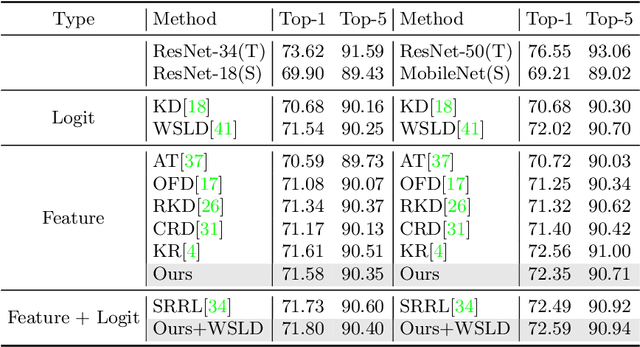
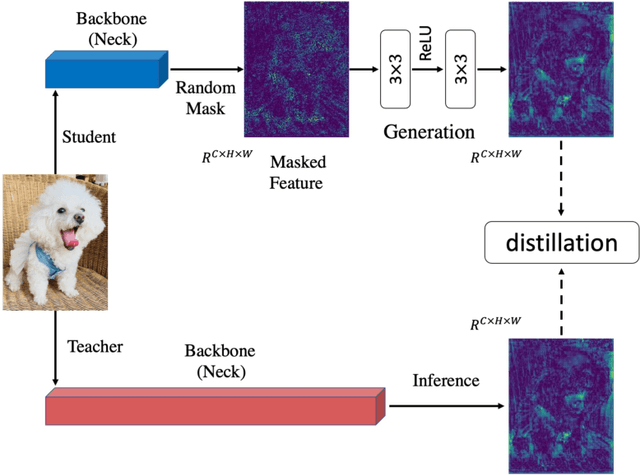
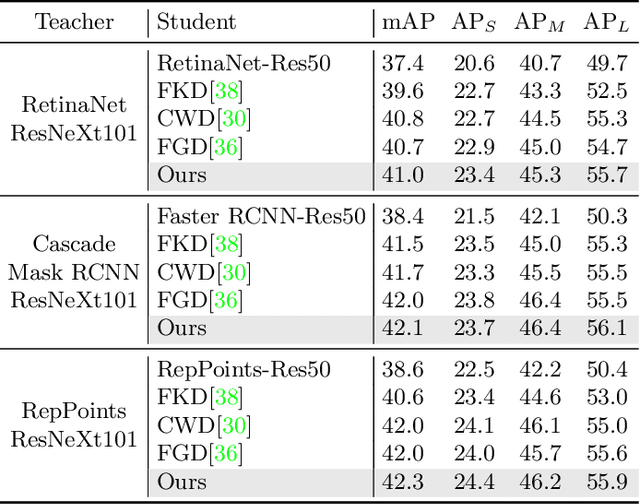
Abstract:Knowledge distillation has been applied to various tasks successfully. The current distillation algorithm usually improves students' performance by imitating the output of the teacher. This paper shows that teachers can also improve students' representation power by guiding students' feature recovery. From this point of view, we propose Masked Generative Distillation (MGD), which is simple: we mask random pixels of the student's feature and force it to generate the teacher's full feature through a simple block. MGD is a truly general feature-based distillation method, which can be utilized on various tasks, including image classification, object detection, semantic segmentation and instance segmentation. We experiment on different models with extensive datasets and the results show that all the students achieve excellent improvements. Notably, we boost ResNet-18 from 69.90% to 71.69% ImageNet top-1 accuracy, RetinaNet with ResNet-50 backbone from 37.4 to 41.0 Boundingbox mAP, SOLO based on ResNet-50 from 33.1 to 36.2 Mask mAP and DeepLabV3 based on ResNet-18 from 73.20 to 76.02 mIoU. Our codes are available at https://github.com/yzd-v/MGD.
Deep Learning based Virtual Point Tracking for Real-Time Target-less Dynamic Displacement Measurement in Railway Applications
Jan 20, 2021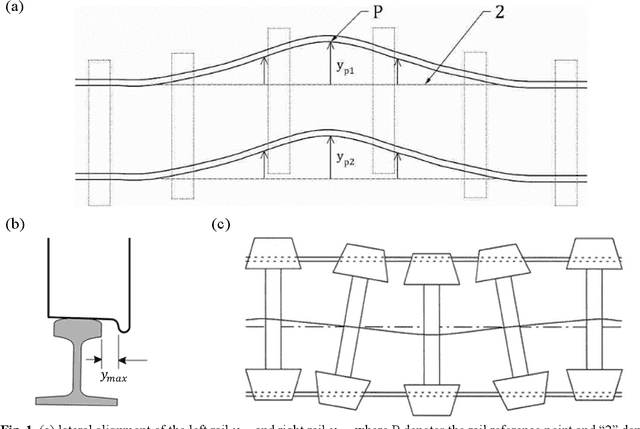
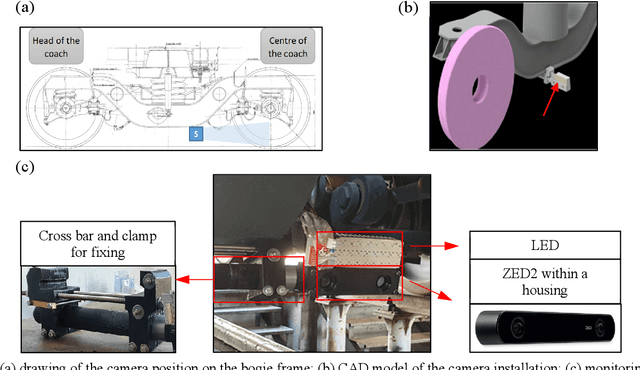
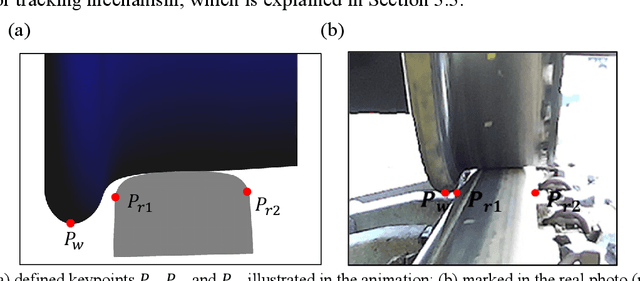
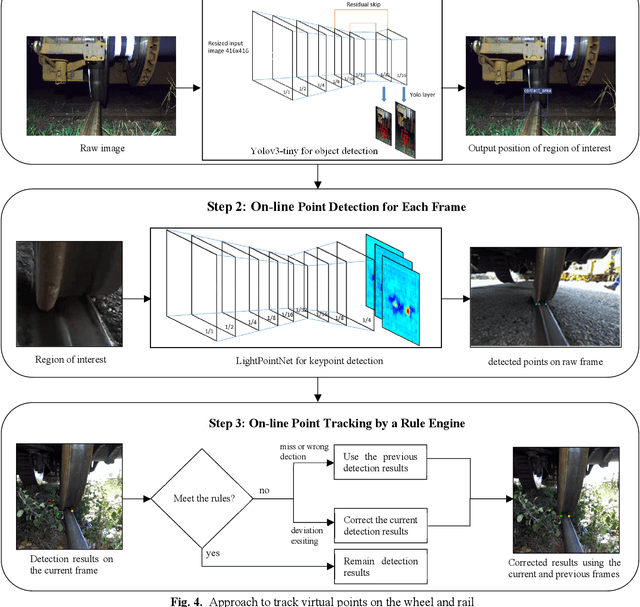
Abstract:In the application of computer-vision based displacement measurement, an optical target is usually required to prove the reference. In the case that the optical target cannot be attached to the measuring objective, edge detection, feature matching and template matching are the most common approaches in target-less photogrammetry. However, their performance significantly relies on parameter settings. This becomes problematic in dynamic scenes where complicated background texture exists and varies over time. To tackle this issue, we propose virtual point tracking for real-time target-less dynamic displacement measurement, incorporating deep learning techniques and domain knowledge. Our approach consists of three steps: 1) automatic calibration for detection of region of interest; 2) virtual point detection for each video frame using deep convolutional neural network; 3) domain-knowledge based rule engine for point tracking in adjacent frames. The proposed approach can be executed on an edge computer in a real-time manner (i.e. over 30 frames per second). We demonstrate our approach for a railway application, where the lateral displacement of the wheel on the rail is measured during operation. We also implement an algorithm using template matching and line detection as the baseline for comparison. The numerical experiments have been performed to evaluate the performance and the latency of our approach in the harsh railway environment with noisy and varying backgrounds.
 Add to Chrome
Add to Chrome Add to Firefox
Add to Firefox Add to Edge
Add to Edge